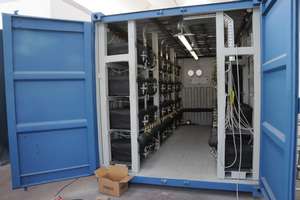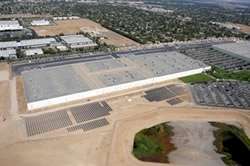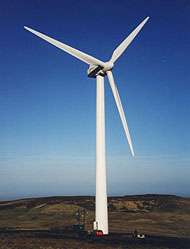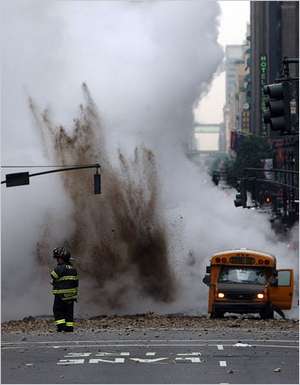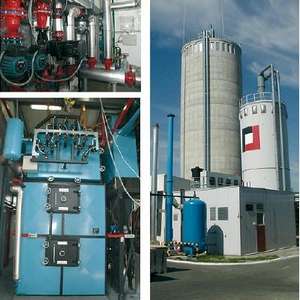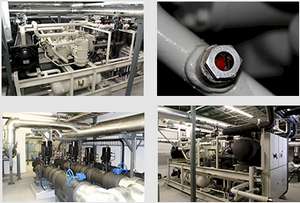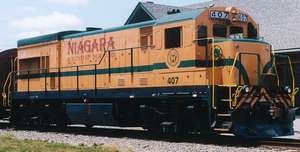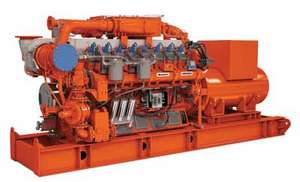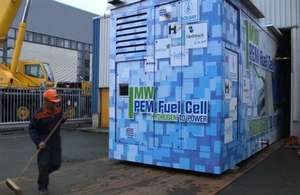How Much is One (1) Megawatt
By
Hank Mills and
Sterling D. Allan
Pure Energy Systems News
October 27, 2011
On
October 28, 2011, Andrea Rossi will allow a customer to test the
world's first one megawatt cold fusion
E-Cat plant. The test will take place in Bologna, Italy, and
will be reported on by Stirling Allan of PESN, who will be present
at the test. This plant is composed of fifty two individual modules
(each the size of a large briefcase), each containing three
individual reactor cores. The combined output of all the modules
will reach one megawatt. The entire system fits inside of a standard
shipping container.
This is a lot of power. One megawatt is big. It might not be as big as a gigawatt or a terawatt, but one megawatt is nothing to dismiss. When it comes from a system that utilizes tiny amounts of nickel and hydrogen as fuel, emits no pollution, and produces no nuclear waste, it becomes a very significant number.
The following is a list of different examples of how one megawatt (or similar amounts of power) can be represented, and how generating one megawatt of power from a cold fusion E-Cat, offers huge advantages over other methods.
600 - 1000 Homes Electricity
The average home in the US uses between 1 and 1.5 kW of electricity on average, so not taking highs and lows into consideration, 1 MW would power between 750 and 1000 homes. http://wiki.answers.com/Q/How_many_homes_can_a_megawatt_power
Home Heat
In terms of heat (as defined by "power" in your college physics text) at 100,000 BTU/hr gas furnace output for a house, this is enough heat for about 30 - 35 homes in Utah on the coldest of nights (-20 F).
Solar Photovoltaic
The 1 MW photovoltaic solar installation by Gap Inc's Western Distribution Center in Fresno, CA takes up five acres, cost $7 million, and took 6 months to build. [1]
A one megawatt cold fusion E-Cat plant would cost a fraction of the cost of the above solar installation, take up less space (one standard shipping container instead of acres of land), produce power 24 hours a day (instead of only during the daytime), and could be constructed in a much shorter period of time.
In fact, a one megawatt E-Cat plant could be transported via the
highway system, and placed onto the site it would be used. The setup
would be minimal, and it would be up and running in hours or days
(instead of months).
Wind Turbines
Most manufacturers of utility-scale turbines offer machines in the 700-kW to 2.5-MW range. Machines of larger size (up to 5 MW) are used in off-shore applications. [2]
To the right is a photo of a wind turbine rated for an output of 1 MW (at optimal wind speed). [3]
The E-Cat technology does not require wind for it to operate. It will operate under any weather conditions. In addition, it is small and easily concealable. It is very difficult to hide a windmill!
An E-Cat plant is simply quicker to build, quicker to install, takes up less space, is cheaper, and is less of an eye sore than a wind farm. In addition, windmills can make noise that is difficult to mask. The form factor of an E-Cat plant makes it easy to sound insulate – despite the fact it is quiet in operation. You can't put a sound insulating box around a windmill!
Steam Explosion
Here is the explosion of a steam in line in New York City, in
2007. This line feeds 20 buildings, which is roughly 1 MW.
Biomass Heat
Here's a 1 MW biomass heat power plant. http://www.nrg-consultants.com/biomass/biomassheatpower5003000kw/1mwheatingplant/index.html "This heating plant was built at a furniture factory in 2001. The heating capacity is 1.0 MW at a maximum flow temperature of 11 0 °C. The plant is operated throughout the year to heat the company property."
Biomass plants require large amounts of fuel, emit pollution, and are yesterday's technology. The E-Cat technology is a game-changing, revolutionary technology that requires only tiny amounts of fuel. For example, a kilogram of nickel could fuel a one megawatt plant for a minimum of six months, or even years. A biomass plant requires it to be continually fed with large amounts – truck loads – of fuel, in this case wood chips. The fuel savings with the E-Cat is simply mind blowing, because perhaps less than a hundred dollars worth of nickel and hydrogen, can replace tens of thousands of dollars worth of bio-mass fuel.
The one megawatt bio-mass plant is a huge facility, that towers
into the sky. A one megawatt E-Cat plant fits into a small, standard
sized container that can be shipped by airplane, cargo ship, or
truck. For the same output, the E-Cat power plant is smaller, more
fuel efficient, quieter, emits less pollution (no pollution), and
makes much more sense.
Heat Pump
Here's a 1 MW heat pump http://www.hastieconsulting.co.nz/Project.aspx?ProjectId=826 "Hastie Consulting in conjunction with Cowley Refrigeration Engineering have recently designed, built and commissioned a 1MW (Cooling) heat pump for a major new commercial building in the Wellington CBD.
The heat pump has been designed to operate as a standard chiller or a heat pump. The heat source for the heat pump mode is the rejected heat from the chilled water circuit, outdoor air or a combination of both. Chilled water from the heat pump is supplied at 5.5 degrees C and heating water at 45 degrees C."
The output from an E-Cat can be used to power a heat pump for
cooling purposes. It would produce cooling at a fraction of the cost
of any other system, because the heat generated would come from
cheap nickel-hydrogen cold fusion reactions.
Locomotive
1 MW is in the range of output of an older locomotive, such as the U18B GE Locomotive shown here, built in 1973-76, which puts out 1.3 MW of power. http://en.wikipedia.org/wiki/List_of_Westinghouse_locomotives http://en.wikipedia.org/wiki/List_of_GE_locomotives
In the not too distant future, E-Cat systems could supply the
steam for locomotives, or produce the electricity to power their
electric motors. It would do so for a tiny fraction of the fuel
cost. A train might use thousands of gallons or diesel for a trip
across the United States, but a cold fusion E-Cat might only use a
few grams of nickel, and a few grams of hydrogen. The cost for the
diesel could run in the thousands of dollars, but the nickel and
hydrogen could only cost a few dollars.
Engine
Here's a video of a 1.8 MW engine starting up:
Technical specification of 1MW diesel generator power plant set from China - consumes 145 grams of fuel/hour per metric horsepower.
These big engines require huge amounts of expensive fossil fuels. Cold fusion E-Cat reactors only require tiny amounts of fuel, in the form of nickel powder and hydrogen gas. The above mentioned diesel generator consumes more fuel by weight in a single hour, than a one megawatt cold fusion E-Cat would consume in a year.
Biogas Engine
GE launches 1 MW gas engine for smaller biogas projects - "GE has introduced its Waukesha APG1000 gas engine that can use a broader variety of biogases, including from landfills, wastewater treatment plants and agricultural "
Once again, the differences are obvious. Biogas engines consume
huge amounts of fuel that when burnt release pollution. E-Cat
generators do not release pollution. The amount of biogas needed to
power the one megawatt engine for a year would fill several giant
trucks. All the nickel and hydrogen needed to power a one megawatt
engine could probably be put in a briefcase.
Fuel Cell
Here's a photo of a 1 MW Fuel Cell power plant by Nedstack, installed in July of 2011: [4] "This PEM Power Plant, with a 1 MW capacity delivered by 12,600 fuel cell stacks, is the largest of this type in the world. The PEM Power Plant converts hydrogen, a by-product in the chlorine industry, into electricity and heat."
Conventional electrolysis is very inefficient, and hydrogen
produced by such systems – or as the byproduct of the chlorine
industry – is expensive when you consider how much input was used to
produce the hydrogen. With nickel-hydrogen cold fusion, a tiny
amount of hydrogen and nickel powder can undergo safe nuclear
reactions, releasing millions of times more energy than “burning”
hydrogen in chemical reactions.
Fission
"The fission of 1 g of uranium or plutonium per day liberates about 1 MW." [5]
Fission can produce huge amounts of power, but there are major drawbacks. The fuel can be expensive, and massive safeguards must be taken when shipping or storing the fuel. Worst of all, the fuel is radioactive, and hazardous to humans and animals.
To use the fission material as fuel, giant and expensive nuclear reactors are built. They cost billions of dollars to build, are expensive to operate, and are inherently dangerous. If the supply of cooling power is cut off, the plant can go into meltdown – the situation in which the fuel melts though the casing of the reactor core.
Geothermal
"To generate 1 MW of geothermal electricity needed funds of about U.S. $ 2.5 million to U.S. $ 3 million. An average well can generate 4.8 megawatts." [6]
Geothermal technology does not require “fuel”, because the heat comes from the Earth. However, it has many disadvantages when compared to the potential of cold fusion E-Cat technology.
Geothermal power plants can only be built at certain locations
where geothermal heat is easy to access. E-Cat plants can be used
anywhere.
You cannot transport a geothermal plant. An E-Cat plant could be
transported anywhere.
Geothermal power could not be used as an on demand power source
for vehicles. In the not too distant future, cold fusion vehicles
could be produced in which the heat is converted into electricity by
photo-thermalvoltaic panels.
In every way, nickel-hydrogen cold fusion technology holds the
advantage over conventional sources of power. The one megawatt of
power from the one megawatt E-Cat plant is a big deal. It represents
the first practical cold fusion power plant, and offers an output
that is industrially significant. It has accomplished this
without....
Emitting any radioactivity.
Using any radioactive substances.
Using any expensive fuels.
Using large quantities of any fuel.
Releasing any pollution.
Producing large amounts of noise.
Being overly large or an eye sore.
Depending on the weather.
Being limited to certain geologic regions of the planet.
Being capable of only being used in the daytime.
Having huge start-up costs.
Taking extended periods of time to setup.
Having any risk of “melt down” or creating a disaster.
www.pureenergysystems.com
PES Network, Inc.
Copyright © 2003 - 2011
